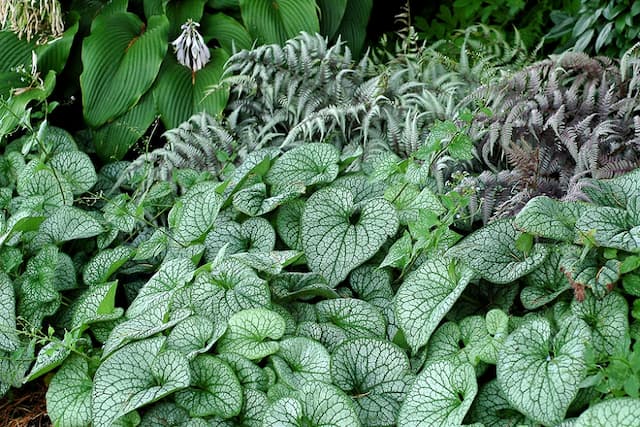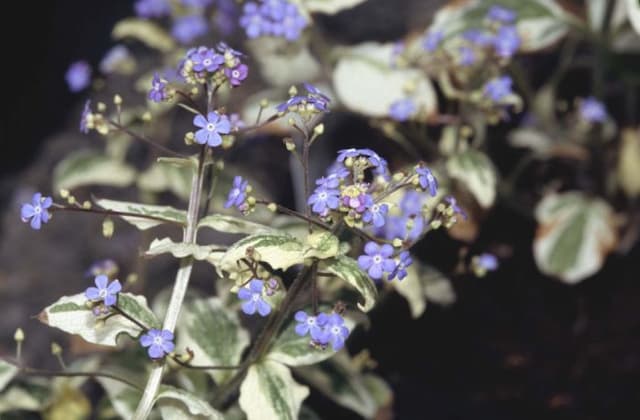Lithodora Heavenly Blue Glandora prostrata 'Heavenly Blue'

ABOUT
Heavenly Blue, commonly known as Lithodora, is an attractive flowering plant characterized by its brilliant blue flowers. These blossoms are vibrant in hue and typically have five petals, giving them a star-like shape. Each petal is often edged, lending a delicate and textured look to the overall flower. The center of each flower showcases a white to lighter blue pattern, creating stunning contrast against the deeper blue petals. The foliage of Heavenly Blue is equally noteworthy. The leaves are small and narrow, with a glossy, dark green appearance that provides a lush backdrop for the bright flowers. These leaves are evergreen, which means the plant maintains its verdant color throughout the year, adding to the appeal of the garden in every season. The branching habit of the plant creates a dense mat of foliage, which helps to suppress weeds and cover the ground effectively. Heavenly Blue is appreciated not only for its vivid flowers and foliage but also for its ability to spread and fill garden spaces, softening edges and bringing a splash of color to rock gardens, borders, or slopes. Its pleasing form and eye-catching hues make it a popular choice for gardeners looking to add a pop of color to their outdoor spaces.
About this plant
 Names
NamesFamily
Boraginaceae
Synonyms
Trailing Lobelia, Prostrate Pygmyweed, Low Matweed, Creeping Glandora, Heavenly Blue Lithodora
Common names
Lithodora prostrata 'Heavenly Blue', Lithospermum prostratum 'Heavenly Blue'
 Toxicity
ToxicityTo humans
The plant commonly known as Lithodora 'Heavenly Blue' is not known for being highly toxic to humans. However, if any part of the plant is ingested, it can potentially cause mild stomach upset. It's always advisable to avoid eating or coming into contact with garden plants if their edibility is unknown or uncertain.
To pets
Lithodora 'Heavenly Blue' is not commonly listed as a toxic plant to pets. However, as with many ornamental plants, it may cause mild gastrointestinal upset if ingested by pets, such as vomiting or diarrhea. To ensure the safety of your pets, it is always best to keep them from ingesting plants not intended for consumption.
 Characteristics
CharacteristicsLife cycle
Perennials
Foliage type
Evergreen
Color of leaves
Green
Flower color
Blue
Height
1 foot (0.3 meters)
Spread
2 feet (0.6 meters)
Plant type
Shrub
Hardiness zones
8
Native area
Mediterranean
Benefits
 General Benefits
General Benefits- Low Maintenance: Requires minimal care once established, making it ideal for gardeners of all skill levels.
- Drought Tolerant: Can withstand dry conditions, reducing the need for frequent watering.
- Attracts Pollinators: Flowers provide nectar for bees and butterflies, promoting biodiversity.
- Ground Cover: Spreads effectively to cover bare spots, reducing soil erosion and suppressing weeds.
- Ornamental Value: Bright blue flowers and evergreen foliage add aesthetic appeal to gardens.
- Cold Hardy: Resistant to frost, suitable for growing in a range of climates.
- Edging Plant: Ideal for borders and edging paths, providing clear lines and structure in landscaping.
- Rock Gardens: Well-suited for rock gardens due to its alpine habitat origin and spreading habit.
 Medical Properties
Medical PropertiesThis plant is not used for medical purposes.
 Air-purifying Qualities
Air-purifying QualitiesThis plant is not specifically known for air purifying qualities.
 Other Uses
Other Uses- Lithodora 'Heavenly Blue' can be used as a natural dye for fabrics, bestowing a subtle, blueish hue derived from its vibrant flowers.
- In a garden setting, this plant serves as a living mulch, suppressing weeds and retaining soil moisture with its dense ground-covering habit.
- The plant is effective in erosion control, stabilizing slopes and banks with its root system that spreads across the soil surface.
- Due to its adaptability to rock gardens, Lithodora 'Heavenly Blue' can be utilized in creating picturesque alpine garden scenes and rockery displays.
- It can serve as a natural indicator plant by reacting visibly to certain soil conditions, such as excessive alkalinity, which can cause its leaves to yellow.
- Lithodora 'Heavenly Blue' is beneficial for xeriscaping, used in landscaping to reduce the need for irrigation.
- This plant can be used for decorative purposes in seasonal floral arrangements, especially as a fresh, blue accent when in bloom.
- It's useful in butterfly gardens, attracting a variety of pollinators with its bright flowers while providing a nectar source.
- The dense growth habit of Lithodora 'Heavenly Blue' makes it suitable as a living edge or border in garden designs, defining walkways or garden sections.
- Its vibrant blue flowers can provide a natural coloring agent for artisanal crafts, such as eco-printing on paper or fabrics.
Interesting Facts
 Feng Shui
Feng ShuiThe Lithodora is not used in Feng Shui practice.
 Zodiac Sign Compitability
Zodiac Sign CompitabilityThe Lithodora is not used in astrology practice.
 Plant Symbolism
Plant Symbolism- Serenity: The 'Heavenly Blue' in the common name suggests a calmness or tranquility associated with the blue sky, promoting a sense of peace.
- Harmony: The use of this plant in garden designs is often to create a harmonious flow with its sprawling habit and soothing color.
- Inspiration: The bright blue flowers may symbolize inspiration, reflecting the uplifting nature of a clear blue heaven.
- Trust: Blue is commonly connected to trust and reliability, so the 'Heavenly Blue' flowers might be seen as a symbol of these qualities.
- Constancy: As many blue flowers have a prolonged blooming period, they may represent constancy and enduring presence.
 Water
WaterLithodora 'Heavenly Blue' prefers to be watered deeply but infrequently, ensuring the soil dries out slightly between waterings. Generally, you should water this plant once every one to two weeks, with about 1 to 1.5 gallons per plant each time, depending on the weather conditions and soil drainage. Always check the soil moisture level before watering to avoid overwatering. In the hot summer months, you might need to water more frequently, but in cooler seasons or when it's raining, reduce the amount of water. Ensure good drainage to prevent root rot, as Lithodora doesn't like to sit in wet soil.
 Light
LightLithodora 'Heavenly Blue' thrives best in full sun to partial shade. An ideal location would provide it with at least six hours of direct sunlight each day. Too much shade can reduce blooming and cause the plant to become leggy.
 Temperature
TemperatureLithodora 'Heavenly Blue' grows well in a wide range of temperatures but prefers cooler conditions with temperatures ranging from 60 to 75 degrees Fahrenheit. It can survive minimum temperatures down to about 20 degrees Fahrenheit, but it will struggle in very hot climates where temperatures consistently exceed 80 degrees Fahrenheit.
 Pruning
PruningLithodora 'Heavenly Blue' can be pruned to maintain shape and encourage denser growth. Pruning is best done after the flowering season ends, typically in late spring or early summer. Remove up to one-third of the plant's size, cutting just above a set of leaves. Regularly deadheading spent blooms will also promote additional flowering.
 Cleaning
CleaningAs needed
 Soil
SoilLithodora 'Heavenly Blue' thrives best in well-drained, sandy soil with added gravel or perlite to increase drainage. Aim for a slightly acidic to neutral pH of 5.5 to 7.0. Incorporate organic matter like compost to add nutrients.
 Repotting
RepottingLithodora 'Heavenly Blue' doesn't require frequent repotting and should be repotted every 2 to 3 years or when it outgrows its current container to avoid becoming root-bound.
 Humidity & Misting
Humidity & MistingLithodora 'Heavenly Blue' is adaptable to a wide range of humidity levels but prefers moderate conditions. It does not require high humidity environments and will fare well in typical outdoor humidity.
 Suitable locations
Suitable locationsIndoor
Ensure full sun, well-drained soil, and infrequent watering.
Outdoor
Choose sunny spot, plant in well-draining soil, water moderately.
Hardiness zone
6-8 USDA
 Life cycle
Life cycleGlandora prostrata 'Heavenly Blue', commonly known as Lithodora 'Heavenly Blue', begins its lifecycle as a seed which, once sown, germinates in favorable conditions of warmth and moisture. Upon germination, the seedling emerges, developing roots and a pair of primary leaves. As the plant grows, it enters the vegetative stage, forming a low, mat-forming evergreen shrub with narrow, dark green leaves. After establishing its foliage, the Lithodora 'Heavenly Blue' enters the flowering stage, typically in late spring to early summer, showcasing its intense blue flowers. Following pollination, which is often aided by insects, the flowers will develop into fruit, containing seeds that will disperse to give rise to new plants. Finally, as a perennial, it will enter a phase of dormancy during the winter, only to restart its growth cycle with the return of favorable conditions in spring.
 Propogation
PropogationPropogation time
Spring-early summer
Glandora prostrata 'Heavenly Blue', more commonly known as Lithodora 'Heavenly Blue', can be propagated effectively through softwood cuttings. This process is best carried out in late spring or early summer when the plant's new growth is mature enough yet still tender. To propagate, a gardener should select a healthy, non-flowering shoot and cut a 4 to 6 inch (about 10 to 15 cm) length, making the cut just below a leaf node. The lower leaves are removed, and the cutting is dipped in rooting hormone powder to encourage root development. Afterwards, the prepared cutting is placed in a pot filled with a mix of peat and perlite; ensuring good drainage is critical. The pot should then be placed in a warm location with indirect light and covered with plastic to maintain humidity. With consistent moisture, roots should form within a few weeks, after which the new Lithodora 'Heavenly Blue' plants can be gradually acclimated to outside conditions and planted in the garden.









